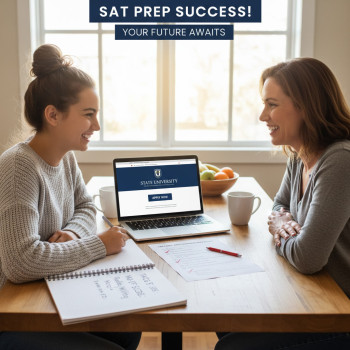Why sleep is your secret SAT advantage
Imagine walking into the test center clear-headed, steady, and able to focus on each question without your mind fogging over. That clarity doesn’t come from one last frantic cram session — it comes from sleep. The night (and nights) leading up to the SAT shape how your brain retrieves facts, solves problems, and handles the small stresses that pop up during the test.
Sleep is not just a luxury; it’s a cognitive tool. Memory consolidation, attention, reaction time, emotional regulation, and problem-solving all depend on getting the right kind of rest. For students preparing for a high-stakes test like the SAT, sleep is the unsung study aid that multiplies the return on every minute of study you put in.
The science in plain English
During sleep, your brain sorts and stores what you learned that day. Different phases of sleep help in different ways: deeper sleep (slow-wave sleep) supports consolidating factual information and strengthening neural connections, while REM sleep helps with creative problem solving and integrating complex ideas. Shorting either of these phases can leave you alert but inefficient — you might remember details but lose the ability to apply them quickly under pressure.
For teenagers and young adults, the recommendation is roughly 8–10 hours per night. Practically speaking, most high school seniors do well with 8–9 hours. That’s the baseline you should aim for during the weeks leading up to the SAT.
What to do in the week before the SAT
Slow and steady beats last-minute binges
There’s a myth that staying up late and cramming will give you an extra boost. In reality, chronic sleep restriction makes your attention, speed, and reasoning worse. Instead of sacrificing sleep, spread your review out and use efficient strategies: active recall, timed practice sections, and targeted review of weak areas.
A realistic plan for the week
- Two weeks before: start moving bedtime earlier by 15–30 minutes every two days if you’re a night owl.
- One week before: stabilize at your target bedtime so you hit consistent sleep for several nights in a row.
- Night before: stick to the routine you’ve practiced — do not attempt a dramatic late-night cram.
- Morning of the test: follow a calm, familiar routine and eat a balanced breakfast.
Practical bedtime routine that actually works
60–90 minutes before bed: wind down
Rituals prime your body for sleep. Try a short, repeatable routine like this:
- Turn off bright screens or use a blue-light filter. Light suppresses melatonin, the sleep hormone.
- Do 10–15 minutes of low-intensity review if it helps your confidence — a quick set of flashcards or reading a summary — then stop.
- Practice a simple relaxation technique: deep breathing, progressive muscle relaxation, or a short guided visualization.
- Set your alarm and lay out everything for test day so no last-minute decisions create anxiety.
Bedroom environment
- Keep the room cool (around 65–68°F / 18–20°C usually works well).
- Block out light with curtains or an eye mask.
- Reduce noise with a fan or white-noise app if needed.
- Reserve your bed for sleep and light quiet activities — avoid doing heavy study or scrolling in bed.
What to eat and drink
Timing and choices matter
Caffeine helps focus in the short term, but it can interfere with sleep for many people, and its half-life is several hours. Aim to stop caffeine no later than the early afternoon on the day before the SAT. If you’re sensitive, avoid it entirely in the afternoon.
For dinner, choose a balanced meal with lean protein, complex carbohydrates, and vegetables — think chicken with brown rice and steamed vegetables or a hearty salad with quinoa. Carbs can help with serotonin production and may make you sleepier at night, while protein supports steady blood sugar overnight.
On test morning, prefer a breakfast that blends slow-release carbohydrates and protein: oatmeal with nuts, toast with peanut butter and banana, or yogurt with fruit and granola. Avoid a huge sugary load that might spike then crash your energy.
Naps: use them wisely
Smart nap rules
- Short nap rule: 20–30 minutes is ideal for a quick alertness boost without grogginess.
- Timing: take naps before 3pm to avoid interfering with nighttime sleep.
- Avoid long naps late in the day — they can push your bedtime later and disrupt sleep cycles.
Many students find a 20–30 minute nap the afternoon before the test helps with attention without wrecking the night.
Table: Sample sleep schedule options by test-day wake time
| Planned Test Entry Time | Wake-up Time | Target Sleep Duration | Suggested Bedtime (night before) | Pre-bed wind-down |
|---|---|---|---|---|
| 8:00 AM | 6:30 AM | 8–9 hours | 9:30–10:30 PM | Start winding down by 9:00 PM; light review only |
| 9:00 AM | 7:15 AM | 8–9 hours | 10:15–11:15 PM | Begin calm routine by 10:00 PM; limit screens |
| 10:30 AM | 8:00 AM | 8–9 hours | 11:00 PM–12:00 AM | Wind-down by 10:30 PM; avoid heavy study in bed |
How to pick your exact bedtime
Pick a wake time that gives you 90–120 minutes before you need to leave for the test for a calm morning. Then count back 8–9 hours to find your target bedtime. Practice this for a few nights leading up to the SAT rather than trying a one-night miracle.
Handling pre-test anxiety that keeps you awake
Practical tools to quiet your mind
- Write it down: spend five minutes listing the things you’re worried about and one concrete, immediate action for each (e.g., “pack calculator” → done).
- Use a short breathing routine: inhale 4s, hold 1s, exhale 6–8s for 5–10 minutes. This lowers heart rate and calms the nervous system.
- Visualization: imagine a calm testing room routine — arriving early, finding your seat, turning the page to the first section. Picture the details; familiarity reduces anxiety.
- Limit problem-solving in bed: if your brain insists on rehearsing difficult questions, keep a pad nearby to jot down a quick thought and tell yourself you’ll handle it in the morning.
Night-before and morning-of strategies
The night before
- Brief review only: skim a list of formulas or a one-page summary. Avoid learning anything new.
- Prepare logistics: pack your admission ticket, photo ID, calculator with fresh batteries, snacks, water, and a light jacket.
- Try to keep social plans calm — big outings can be stimulating and disrupt sleep.
Morning of the test
- Wake at your practiced time; avoid the temptation to snooze repeatedly.
- Eat a balanced breakfast with carbs and protein; hydrate but avoid excessive liquids right before the test to reduce bathroom breaks.
- Do a 5–10 minute light review: glance through an easy, confidence-boosting summary or a couple of formulas.
- Arrive early to the test center to reduce last-minute stress.
Real-world examples: what students actually do
Case study: Maya’s turnaround. Maya was an avid night owl. Two weeks before her SAT she started shifting her bedtime 20 minutes earlier every three nights, practiced short naps, and stopped caffeine after noon. She replaced marathon late-night study sessions with two focused evening 45-minute study blocks and a calm wind-down routine. On test day she reported feeling sharper and more patient on reading passages; her timing improved because she wasn’t tired at the end of each section.
Contrast: Alex crammed until 2am and slept five hours. On the test he was accurate on questions he knew, but he lost precious time rereading prompts and struggled with complex math problems that required several steps. The difference between Maya and Alex wasn’t IQ — it was sleep and strategy.
Tools and trackers: use but don’t obsess
Helpful technology
- Sleep trackers can show trends — if they consistently indicate short sleep or late bedtimes, adjust behavior.
- Use blue-light filters or night modes on devices in the evening to reduce melatonin suppression.
- Set calming alarms with gentle sounds to avoid jarring awakenings that spike cortisol.
Trackers are guides, not judges. If a device says you slept poorly, focus on what you can control tonight rather than getting more anxious.
How Sparkl’s personalized tutoring fits into your sleep-smart prep
Balancing study with sleep is easier when your practice is efficient and targeted. That’s where Sparkl’s personalized tutoring can help: one-on-one guidance and tailored study plans keep your prep focused so you don’t need to binge late at night. Expert tutors can identify high-impact areas to review, and Sparkl’s AI-driven insights help highlight patterns in your practice tests so you know exactly what to reinforce — saving time and protecting your sleep schedule.
When students work with a tutor who schedules realistic, focused sessions and models time management, they often sleep better because they feel prepared without desperation. If you use a tutor, aim for consistency: regular short sessions beat erratic marathon sessions that wreck your nightly routine.
Common pitfalls and how to avoid them
Don’t do this
- All-night cramming the night before — it reduces performance more than it helps.
- Chasing sleep with weekend lie-ins that create a Monday morning misalignment.
- Using energy drinks or late-night caffeine to study past your natural limits.
- Letting screens and bright lights push your bedtime later and later.
Instead try this
- Plan short, active study sessions and then close the books early enough to sleep.
- Stabilize your sleep schedule across the week rather than only on weekends.
- Prioritize recovery: if you have a bad night, aim for consistent sleep the next few nights rather than panicking.
Last-minute checklist for the night before
- Easy dinner; no heavy, spicy foods right before bed.
- Pack everything for test day and place it by the door.
- Do a 10–15 minute light review, then put the books away.
- Follow your wind-down routine and get into bed at your practiced time.
- Use a breathing exercise if you feel worried and remind yourself: you did the work.
Final thoughts: sleep as an act of strategy, not luck
Preparing for the SAT is as much about what you do to rest as how you study. Think of sleep as part of your study plan — a predictable, trainable skill that amplifies everything you’ve learned. When you prioritize consistent sleep, you sharpen attention, speed up recall, and improve your emotional resilience on test day.
Make sleep part of your practice. Set a realistic schedule, use short focused study blocks, practice calming rituals, watch your caffeine and naps, and arrive at the test center with a calm morning routine. If you want extra structure, consider Sparkl’s personalized tutoring for tailored study plans, 1-on-1 guidance, and AI-driven insights that help you study smarter — and sleep better — in the lead-up to the SAT.


Good sleep won’t replace practice, but it will multiply its value. Treat your sleep like preparation — plan it, protect it, and practice it. The SAT is a long day of focus; give your brain the fuel it needs to do its best.









No Comments
Leave a comment Cancel